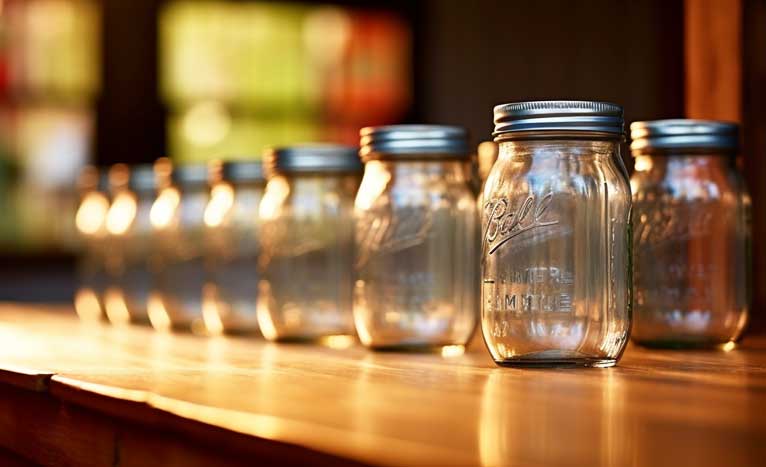Mason jars are a versatile and convenient choice for storing various types of foods, including freeze-dried items. Freeze-dried foods are popular for their long shelf life and nutritional value, making them a smart choice for emergency preparedness or simply extending the lifespan of your favorite snacks. In this blog, we'll explore the steps and tips for properly storing freeze-dried foods in mason jars to keep them fresh and accessible.
On my socials, I post about my Harvest Right Freeze Dryer every time I use it on the homestead. I freeze dry vegetables, milk, and fruit. People love to see the process and I love to share the steps and how freeze-drying is one of my favorite methods of food preservation. A freeze dryer is an investment into your food storage. One question I am constantly asked is: “How do you store your freeze-dried goods?” so I figured I would write a blog post about it and how I utilize my mason jars for it!

Why Choose Mason Jars for Freeze-Dried Foods?
Mason jars offer several advantages for storing freeze-dried foods:
Airtight Seal: Mason jars come with screw-on lids that create a reliable airtight seal. This seal helps prevent moisture and oxygen from reaching the contents, which is crucial for maintaining the freshness of freeze-dried foods. Check out a variety of Mason jars on Amazon.
Visibility: Mason jars are transparent, allowing you to see the contents without opening the container. This makes it easy to identify the food stored inside. I also love that I am able to look at my food storage and see what is going on. I can also see if food has spoiled or if there are any issues I need to address.
Durability: Mason jars are made of thick glass that is less likely to break or crack compared to plastic containers. They can withstand temperature changes and resist staining and odors. I would be careful with the mason jars if you are changing them from one extreme to another—hot to cold or cold to hot—they may crack!
Versatility: Mason jars come in various sizes, making them suitable for storing different quantities of freeze-dried foods. They are also easy to label for organization.

Steps for Storing Freeze-Dried Foods in Mason Jars
Step 1: Gather Your Supplies
- Before you begin, gather the necessary supplies: Freeze-dried foods of your choice.
- Mason jars with screw-on lids.
- Oxygen absorbers (optional but recommended for long-term storage).
- Airtight vacuum sealer (optional but helpful).
- Labels and a permanent marker for dating and labeling the jars.
Step 2: Prepare the Mason Jars
Ensure that your mason jars and lids are clean and dry. Check for any cracks or defects in the glass or the sealing gaskets of the lids. It's essential to start with clean and intact containers to maintain the integrity of your freeze-dried foods.
Step 3: Add Freeze-Dried Foods
Carefully fill the mason jars with the freeze-dried foods you want to store. Leave some space at the top to allow for the placement of an oxygen absorber and for better sealing. Be sure not to overfill, as this can make it difficult to achieve an airtight seal.
Step 4: Use Oxygen Absorbers
If you plan to store freeze-dried foods for an extended period, it's advisable to use oxygen absorbers. These packets help remove any remaining oxygen in the jar, further preserving the freshness of the contents. Place the oxygen absorber on top of the freeze-dried foods before sealing the jar.
Step 5: Seal the Mason Jars
Screw the lids onto the mason jars firmly but not excessively tight. You want to create an airtight seal without risking damage to the jar or lid threads. If you have an airtight vacuum sealer, you can use it to remove excess air from the jars before sealing for even better preservation. I love to organize my freezer and refrigerator space with my vacuum sealer.
Step 6: Label and Date
Use labels and a permanent marker to write the contents and date of storage on each mason jar. This information helps you keep track of the foods in your storage and ensures that you use them before their recommended shelf life expires.
Looking for printable labels to make your organization even easier? Check out my printable labels in my shop here.
Step 7: Store in a Cool, Dark Place
Store your sealed mason jars of freeze-dried foods in a cool, dark place away from direct sunlight and extreme temperature fluctuations. A pantry, cupboard, or cellar is an ideal storage location. Keep the jars off the floor to prevent moisture absorption.
Tips for Successful Storage
- Always store freeze-dried foods in a clean, dry environment to prevent moisture and spoilage.
- Rotate your stock by using older items first and replacing them with fresh ones.
- Check your stored items periodically to ensure the seals remain intact.
- Store a variety of freeze-dried foods to maintain a balanced and versatile emergency food supply.
By following these steps and tips, you can effectively store freeze-dried foods in mason jars, ensuring that you have access to nutritious and delicious meals for an extended period. Whether you're preparing for emergencies or simply looking to prolong the shelf life of your favorite snacks, mason jars provide a reliable and practical solution.

